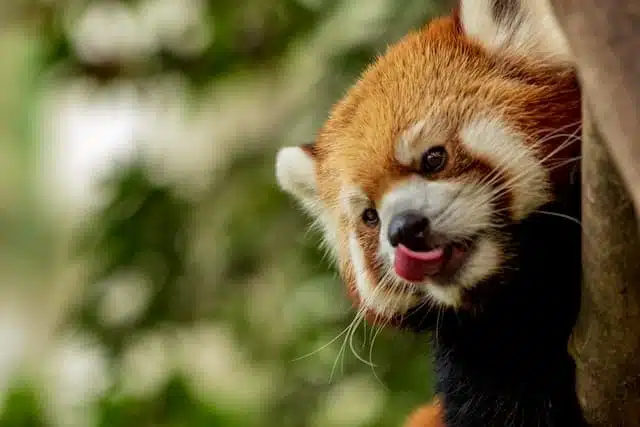How could one not love this copper-coloured fluffy creature? Tragically they are risking extinction, but the first step to saving their species is to educate yourself about them.
Continue reading and become an expert on Red Pandas!
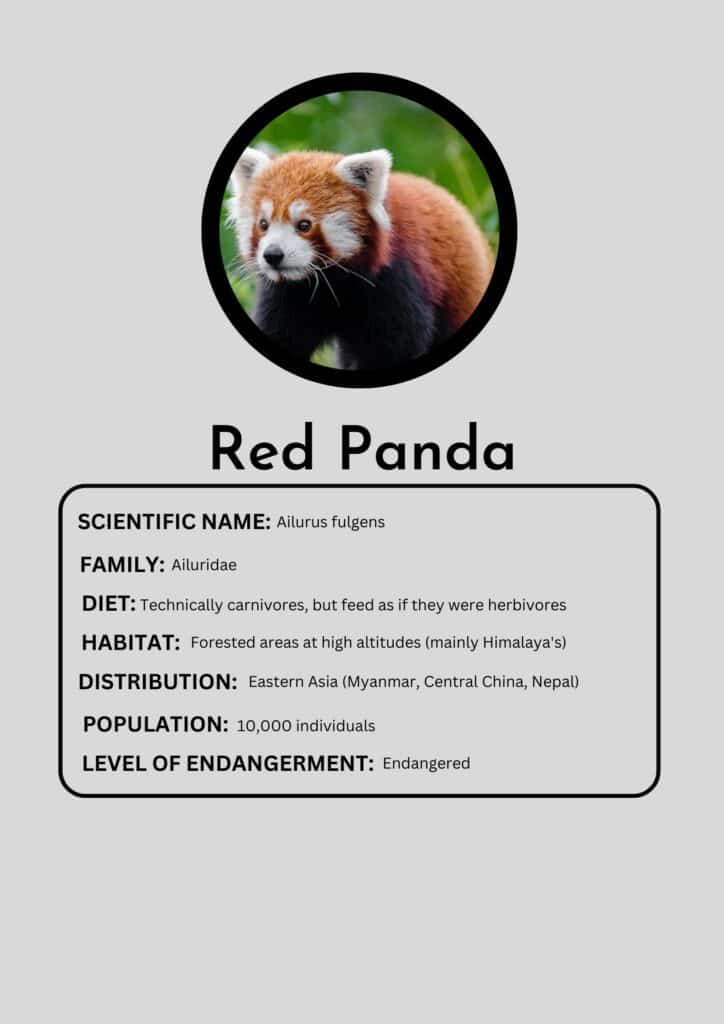
Appearance
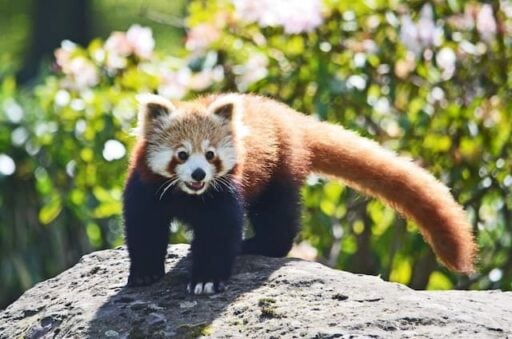
The Red Panda belongs to the Ailuridae family. They are the only creatures within this family that have not gone extinct yet, although they are dangerously close to doing so.
Contrary to what the name suggests, they are not very closely related to the Giant Panda. Instead, their close-ish relatives include raccoons, weasels and skunks. However, this is a hotly debated question amongst DNA researchers and not universally accepted.
There are two species of Red Panda; the Himalayan Red Panda and the Chinese Red Panda. Although challenging to differentiate, the Chinese Red Panda is a touch bigger and has more prominent tail-rings. The former weighs 30 lbs on average, and the latter weighs 20 lbs.
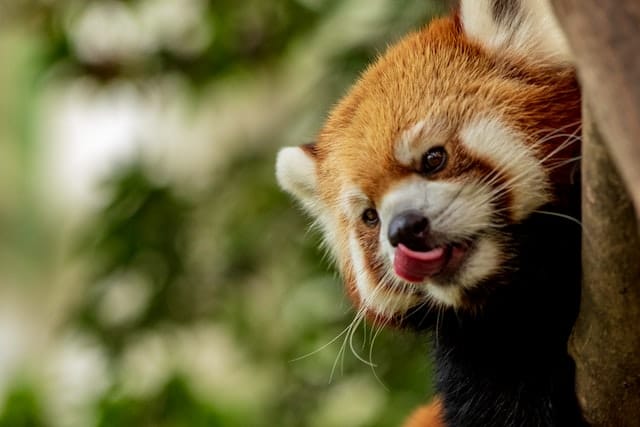
The appearance of the Red Panda is similar to that of a raccoon, and their size is equivalent to that of a domesticated cat. Their coat consists of thick and fluffy fur. As its name implies, the fur is mainly a reddish copper color, except for its black belly and legs, and the white markings that highlight their face and ears. Its fluffy tail, which measures 20 inches, has stripes of dark brown rings.
Their habitat features lots of red moss, and so their red color scheme is thought to have evolved to camouflage them.
Red Pandas are famous acrobats. Each paw has 5 semi-retractile claws in order to help them climb trees. Even though their tail can’t grip things, it likewise boosts their climbing abilities – much the same way humans put out their arms to maintain balance. Both forelimbs have an extra thumb which, other than assisting their climbing, allows them to grip their favorite snack; bamboo.
Habitat and Distribution
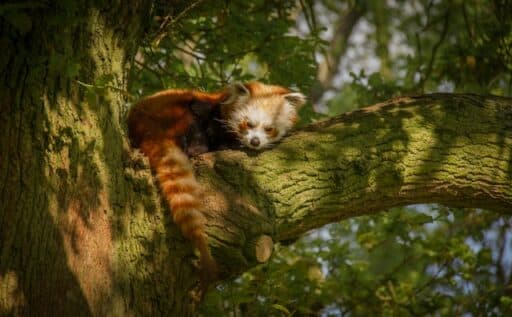
Except for zoos around the world, the Red Panda only exists in Eastern Asia. More specifically, they reside in the countries of Nepal, Myanmar and Central China.
The Red Panda inhabits mountainous forest landscapes. 50% of their total habitat is in the Eastern Himalayas where they occur at altitudes of 6,600 – 14,100 feet. Moreover they require a temperate climate, usually between 64 – 75°F. An individual’s range is fairly small, rarely being further away from a water source than 800 feet.
Thanks to their many adaptations to make them good climbers, they easily swing between branches and are overall incredibly agile beings. Other than for feeding and doing their so-called “business”, they have no reason to be on the ground and spend 90% of their time in trees. In the treetops they sleep and sunbathe, and it is equally a good way of escaping predators such as jackals and snow leopards.
Red Pandas like a dense forest, preferably one with fallen tree trunks and other forest-debris that can help them reach bamboo. Reportedly, Red Pandas are drawn to steep slopes in contrast to Giant Pandas who reside in flat areas. In this way there is much less competition between the two for bamboo, as it is both species’ primary food source.
Diet
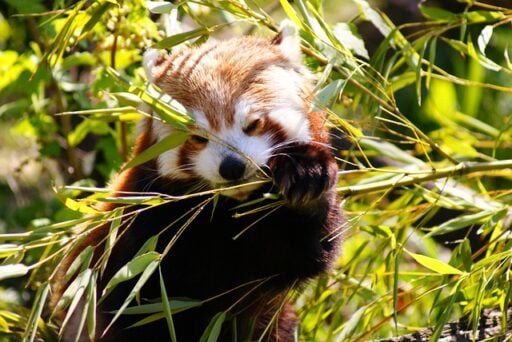
Although the Red Panda’s digestive system is equipped for a carnivorous diet, most of the time they feed as if they were herbivores.
During the winter season their diet consists exclusively of bamboo because it is the only plant able to survive the cold weather. In warmer weather they also consume berries, fruits, eggs and certain small mammals.
Because they are not technically equipped to process bamboo they must eat large quantities of it. On a daily basis they will need to eat 3 lbs bamboo leaves or 9 lbs bamboo shoots to sustain themselves. When eating bamboo they grab the branch and bend it towards their mouth and then start chomping with their molars.
They are nocturnal animals and therefore forage for food during the nighttime, and on occasion at dusk or dawn.
Mating and Life Cycle
The Red Pandas are solitary animals that rarely interact with one another, the breeding season being the only exception. Leading up to the mating, females and males will feed, eat and sleep closer and closer to each other.
Mating takes place during the period between January – March. They mate due to photoperiodism, which is a psychological response to the increase or reduction of sunlight hours.
A female remains pregnant for just over 4 months and then gives birth to a litter of 1-4 cubs, which are fully equipped with fur but completely blind. In anticipation of their arrival the other builds a nest. She uses a hollow log or a rock crevice, which she supplements with branches, leaves and moss.
Babies are fully dependent on their mother for the first three months, but still continue nursing for another two. They become fully grown after a year and remain with their mother until then.
Red Pandas living in captivity typically reach an age of 14 years. In the wild this number is significantly less due to predators and human interference.
Cause of Endangerment
It’s difficult to pinpoint the exact number of Red Pandas remaining today, but experts predict that it is less than 10,000 individuals – granting them the label “endangered” by the IUCN.
Habitat destruction and fragmentation, resulting mainly from deforestation, are the main reasons for their endangerment, a threat they share with so many other species. Likewise, roads disjoin and segregate their habitat, leaving them with less space to roam freely – not to mention the dangers of traffic.
Sadly, the Red Panda is also poached because of its luscious fur. In some instances they are trapped to be sold on the black market for illegal pets.
Fun Facts – That We Bet You Didn’t Know
#1 Fun Fact
Allegedly the Red Panda’s name stems from a Nepali word; “ponya”. Ponya means bamboo or plant eating creature. The Chinese term for Red Panda translates to “fire-fox” – not referring to the web browser.
#2 Fun Fact
Because Red Panda’s are ill-equipped for digesting their diet of choice they defecate huge amounts. In one week they will easily pass volumes equivalent to their body weight. Leading up to breeding season, males will use their strategically defecate as to let the females know that they’re in the neighborhood.
#3 Fun Fact
Their fluffy and characteristic tail not only helps them with balance, it is often re-purposed as a blanket during cold weathers. Also, to keep themselves looking dapper, they lick themselves clean just like domesticated cats.
FAQ
How do Red Pandas communicate?
Seeing as they are highly solitary animals, they don’t communicate much with each other other than through scents. Scents are produced by two glands located at the base of their tail. When breeding season is coming up they rubb off their scents and urinate on trees to alert individuals in the area of their availability.
Why are Red Pandas so important?
The Red Pandas play a crucial role in the eco system of the Himalayas. Their extinction would probably generate the extinction of many other animals which rely on Red Pandas as their prey. Moreover, being keen bamboo eaters they are essential for keeping bamboo growth under control. Bamboo can easily take over, and if not regulated this would cause many other vegetation to diminish.
How do Red Pandas survive the cold?
Its luscious and fluffy fur coat do not only function to make them extremely adorable, it also manages to retain almost a 100% of the Red Pandas body heat. Snow flakes don’t melt when they land on their fur. In this way they don’t become cold and wet when hiking through snow.
Thank you for reading this article! The Red Panda have an equally adorable cousin, the Raccoon, which you can learn more about here.
- Magpie Bird Is Reunited with Her Dog Best Friend - April 24, 2024
- Dog Saves Another Dog From Drowning in Fish Pond - April 23, 2024
- Man On Motorbike Rescues Cat From Highway - April 23, 2024

